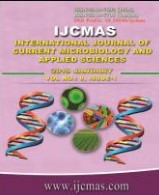


 National Academy of Agricultural Sciences (NAAS)
National Academy of Agricultural Sciences (NAAS)

|
PRINT ISSN : 2319-7692
Online ISSN : 2319-7706 Issues : 12 per year Publisher : Excellent Publishers Email : editorijcmas@gmail.com / submit@ijcmas.com Editor-in-chief: Dr.M.Prakash Index Copernicus ICV 2018: 95.39 NAAS RATING 2020: 5.38 |
A field experiment was conducted during the rabi season of 2016-17 at N.E. Borlaug Crop Research Centre of G.B. Pant University of Agriculture and Technology, Pantnagar (290 N, 79029 E and at an altitude of 243.83 m) to study the effect of planting time and geometry on the growth, yield attributes, yield quality, and the economics of Indian mustard RH 749. The experiment consisting of 15 treatments, having three levels of planting date (14 Oct, 24 Oct and 03 Nov) in main plots and five planting geometries (30×10, 30×20, 30×30, 45×15 and 45×30 cm) in sub plot were studied in split plot design (SPD) with three replication. The soil of the experimental site was silty clay loam with pH 7.3, organic carbon 0.81%; and 264, 20.6 and 235 kg/ha of N, P2 O5 and K2 O, respectively.From the result, sowing during 14th October recorded significantly higher crop yield attributing characters viz. no. of primary, secondary and tertiary branches, number and weight of siliquae /plant and ultimately seed yield (2087 kg/ha) with better growth and higher dry matter accumulation in yield components compared to 24th October and 3rd November. Crop geometry of 30×10 cm recorded significantly higher seed yield (1925kg/ha) with better utilization of space, nutrients, water and sunshine resulting in higher dry matter translocation to yield components as compared to 30×20, 30×30, 45×15, 45×30 crop geometry.
 |
 |
 |
 |
 |